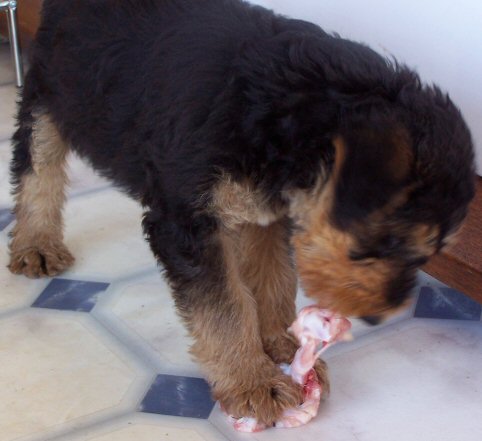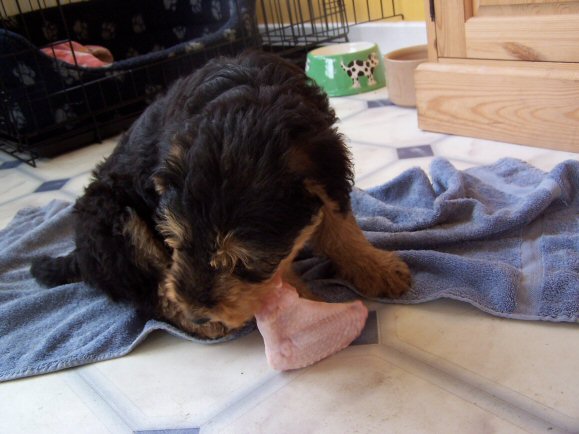Over 20 years ago I came across the books by Juliette de Bairacli Levy, a botanist and herbalist whose knowledge of traditional, gipsy and other lore about rearing animals and children naturally is second to none.
I have used her method to rear 2 litters of puppies the natural way and it produced lovely healthy dogs. One of them stayed with me for 14 healthy years without ever needing veterinary treatment.
When we decided to get an Airedale I did a lot of research into possible health problems that these dogs could develop, hip dysplasia being one of the more serious ones. According to some this condition is inherited, others say it’s acquired. Nutrition seems to be the key to better health, and after many hours surfing the internet we decided a biologically appropriate raw diet – BARF – would be the best thing to hopefully prevent any hip joint and other problems.

Finni came to us at 7 weeks old, fully weaned and with a hearty appetite, he even tried to eat the little bone picture at the bottom of his feeding bowl. His first meal was kibble which the breeder had raised him on. The second meal was a mixture of kibble and hacked chicken wing and this went down very well. The third was a complete raw chicken wing which was literally snatched out of my hand by this 7 week old, as if to say “Ah, proper food. I’m having that!”
After ‘working’ on the chicken wing for 45 minutes he gathered it up in his mouth and headed for the garden to bury it. We realized then that he couldn’t manage it because he didn’t have any backteeth yet! So we gently took it off him, hacked it into small pieces and he quickly ate it all up before going back in his basket to have a long nap.

Until Finni was 9 weeks old we prepared the chicken wings by hacking the long parts of the bones but leaving the end bits intact, and this he managed very well. It only took him around 20 minutes to eat a chicken wing prepared like that. We gradually introduced more different foods and he enjoyed them all. We add NR Garlic Plus powder and Kelp to his food for extra minerals and conditioning.

According to Juliette de Bairacli Levy a healthy digestive system is no place for worms. At 7 months old we stopped feeding raw cereal (soaked in goats milk overnight). Up until then we had detected the odd roundworm in Finni’s ‘output’, but after stopping the cereal altogether we had no more roundworms.
Finni’s digestion is healthy and regular. He cleans his food bowl at every meal and enjoys a bony snack in between meals (to clean his teeth). He also enjoys pigs ears and the odd bonio but his staple diet consists of 80% meat (all human grade) in the form of mince and raw meaty bones (which he eats all), and 20% finely chopped fruit and vegetables.
With a biological appropriate diet you know exactly what goes into the dog – a point recently highlighted by the petfood recalls in America and South Africa.
. . . . . . . . . . . . . . . . . . . . . . . . . .
Vaccinations
Another aspect of natural rearing is the question of vaccination. Finni has not been vaccinated by us but has been given Homeopathic Nosodes instead. Vaccinations are not without side effects and there is no way of predicting which animal will or will not have these side effects. We chose the safer option of giving Finni Homeopathic Nosodes as there are no side effects with these, and in our experience over the last 20 years they work just as well.
If you do feel you have to vaccinate here are some important points made by Donna Starita Mehan,DMV A County Way Veterinary Care 27728 SE Haley Road, Boring, OR 97009 USA
If You Vaccinate
“As a veterinary homeopath, I do not recommend routine vaccination for dogs or cats, except for rabies in healthy dogs. If, for whatever reason, you decide that you must vaccinate your pet, I would make the following recommendations:
1. Never vaccinate an animal with symptoms of acute or chronic health problems, or at the time of surgery or any other physical or emotional stress.
2. Vaccinate for one disease at a time that is, avoid multivalent (combination) vaccines. For cats” vaccinate for feline panleukopenia alone. The vaccines for the two upper respiratory viruses (calicivirus and rhinotracheitis) can be given together. I strongly recommend against vaccination for feline leukemia or feline infectious peritonitis virus. The vaccine is ineffective, and in my opinion, extremely hazardous.
For dogs, give parvo separately from distemper.
Do not vaccinate for leptospirosis, hepatitis” or parainfluenza.
Never give the rabies vaccine at the same time as any other vaccine.
3. Avoid modified live virus vaccines whenever possible. Get killed virus vaccines, especially for rabies, canine parvo virus, and feline panleukopenia. (The canine distemper/hepatitis vaccine is not available in a killed virus form).
4. For middle aged dogs and cats, “vaccinate every 2-3 years” instead of yearly.
5. After vaccination, give a dose of Thuja 30c. Wait one week” then give a dose of Sulfur 6x once daily for 7 days.
Therapeutic Use of Nosodes
In addition to helping prevent specific viral diseases with prophylactic use, nosodes can be used even after exposure to a virus has taken place. If given immediately after exposure, before symptoms develop, these nosodes can prevent the development of clinical disease.
Viral diseases such as feline leukemia, feline infectious peritonitis, canine distemper and canine parvo virus are usually incurable with conventional medical treatment (antibiotics, steroids, etc.).
However, they frequently respond very quickly and favorably to homeopathic treatment. If your pet shows any symptoms of illness, specific, individualized homeopathic treatment will be needed. Due to the potential seriousness of these conditions, you should seek professional help”
